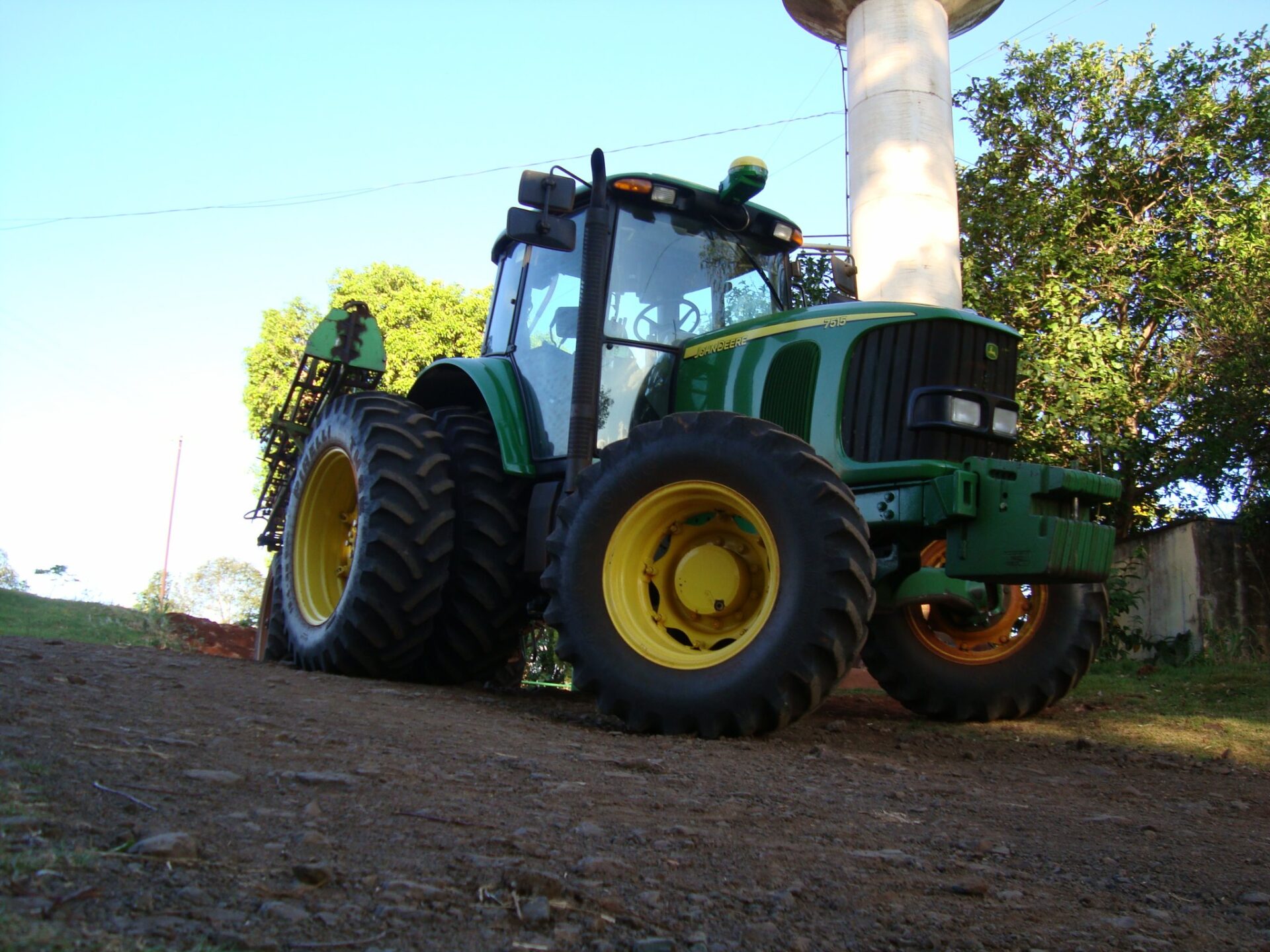The John Deere 7515 is a versatile utility tractor manufactured by John Deere with a production factory located in Montenegro, Brazil. This tractor boasts impressive power and mechanical features, making it suitable for a variety of agricultural tasks.
| Engine | |
|---|---|
| Engine | 140 hp (104.4 kW) |
| PTO (claimed) | 119 hp (88.7 kW) |
| Engine Detail | John Deere 6068T Series 350 turbocharged diesel, 6-cylinder, liquid-cooled |
| Displacement | 414.4 cubic inches (6.8 liters) |
| Bore/Stroke | 4.19×5.00 inches (106 x 127 mm) |
| Rated RPM | 2100 |
| Torque | 449.9 lb-ft (610.1 Nm) at 1500 RPM |
| Starter volts | 12 |
| Coolant capacity | 26.4 quarts (25.0 liters) |
| Mechanical: | |
|---|---|
| Chassis | 4×4 MFWD 4WD |
| Differential lock | electro-hydraulic |
| Steering | hydrostatic power |
| Brakes | hydraulic wet disc |
| Cab | Cab optional |
| Transmission | 16-speed partial power shift |
| Capacity: | |
|---|---|
| Fuel | 81 gallons (306.6 liters) |
| Hydraulic system | 16.9 gallons (64.0 liters) |
| Front axle | 8.7 quarts (8.2 liters) |
| Front hubs | 1.8 quarts (1.7 liters) each |
| Transmission: | |
|---|---|
| Transmission Type | John Deere PowrQuad, partial power shift |
| Gears | 16 forward and reverse |
| Clutch | hydraulic wet disc PermaClutch II |
| Oil capacity | 67.6 quarts (64.0 liters) |
| Oil type | JD Hy-Gard |
| Tires: | |
|---|---|
| Standard tires (ag) | Front |
| Optional tires (ag) | Various options including Front |
| Dimensions: | |
|---|---|
| Wheelbase | 104.3 inches (264 cm) |
| Length | 195.6 inches (496 cm) |
| Height | 112 inches (284 cm) |
| Max weight | 17,640 lbs (8001 kg) |
| Rear axle | Rack-and-pinion |
| Front tread | Adjustable from 63.6 to 84.8 inches (161 to 215 cm) |
| Rear tread | Adjustable from 62.4 to 75.7 inches (158 to 192 cm) |
| Tractor Hitch: | |
|---|---|
| Rear Type | II |
| Control | electronic lower link |
| Rear lift (at ends) | 10,690 lbs (4848 kg) |
| Rear lift (at 24″/610mm) | 6,500 lbs (2948 kg) |
| Power Take-off (PTO): | |
|---|---|
| Rear PTO | independent |
| Clutch | electro-hydraulic |
| Rear RPM | 540/1000 |
| Electrical: | |
|---|---|
| Ground | negative |
| Charging system | alternator |
| Charging amps | 90 |
| Battery volts | 12 |
| Battery AH | 150 |
The John Deere 7515 tractor offers reliable power, versatile transmission options, and various tire choices to suit different agricultural needs, making it a valuable addition to any farm or utility operation.
John Deere 7515 Tractor Advantages
Powerful Engine: The tractor is equipped with a robust 140 hp engine, providing ample power for various agricultural tasks.
Versatile Transmission: The 16-speed partial power shift transmission allows for smooth and efficient gear changes, enhancing productivity in the field.
Hydraulic System: With a 16.9-gallon hydraulic system, it can operate hydraulic implements efficiently.
Four-Wheel Drive: The 4×4 MFWD 4WD chassis ensures excellent traction and stability, especially in challenging terrain and adverse weather conditions.
Differential Lock: The electro-hydraulic differential lock improves traction further, preventing wheel slippage.
Power Take-off (PTO): The independent PTO with electro-hydraulic clutch offers flexibility in powering various implements and attachments.
Adjustable Tread: The tractor’s adjustable front and rear tread widths allow for customization to suit different row spacing requirements.
Rear Hitch: The tractor’s rear hitch with electronic lower link control offers precise implement control and lifting capacity, making it suitable for a wide range of implements.
Reliable Brand: John Deere is a well-established and trusted brand known for producing high-quality agricultural machinery.
John Deere 7515 Tractor Disadvantages:
Tire Options: While it offers tire options, some may find that the standard tire sizes do not meet their specific needs, potentially requiring additional investments.
Complexity: The tractor’s advanced features and technology may require a learning curve for operators who are not familiar with John Deere equipment.
The John Deere 7515 tractor offers impressive power and versatility, making it suitable for a wide range of agricultural tasks. However, potential buyers should carefully consider their specific needs, budget, and operating conditions to determine if it is the right choice for their operation.
